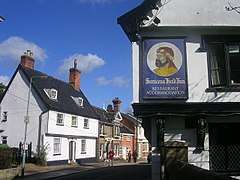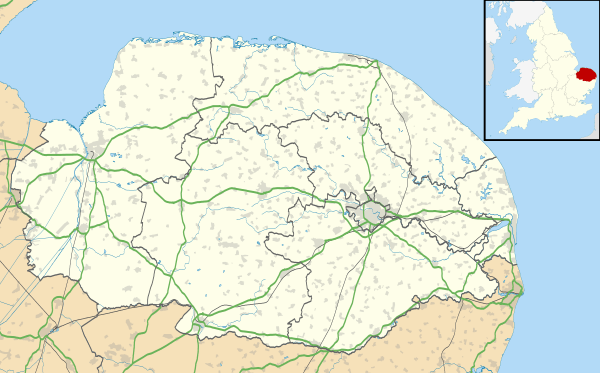Diss
Diss is a market town and electoral ward in South Norfolk, England, close to Norfolk's border with Suffolk. It had a population of 7,572 in 2011.[1] Diss railway station is on the Great Eastern Main Line from London to Norwich. The town lies in the valley of the River Waveney, round a mere covering 6 acres (2.4 ha) and up to 18 feet (5.5 m) deep, although there is another 51 feet (16 m) of mud.[2]
| Diss | |
|---|---|
 The Saracen's Head pub | |
 Coat of arms of Diss Town Council | |
 Diss Location within Norfolk | |
| Area | 5.32 km2 (2.05 sq mi) |
| Population | 7,572 (2011 census) |
| • Density | 1,423/km2 (3,690/sq mi) |
| OS grid reference | TM1180 |
| District | |
| Shire county | |
| Region | |
| Country | England |
| Sovereign state | United Kingdom |
| Post town | DISS |
| Postcode district | IP22 |
| Dialling code | 01379 |
| Police | Norfolk |
| Fire | Norfolk |
| Ambulance | East of England |
| UK Parliament | |
History
The town takes its name from dic an Anglo-Saxon word meaning either ditch or embankment.[3] Diss has a number of historic buildings, including an early 14th-century parish church and an 1850s corn exchange still in operation.[4]
At the time of Edward the Confessor, Diss was part of the Hartismere hundred (a hundred was an administrative subdivision) of Suffolk, and it was recorded as such in the Domesday book. It is recorded as being in the king's possession as demesne (direct ownership) of the Crown, there being at that time a church and a glebe of 24 acres.
This was considered to be worth £15 per annum, which had doubled by the time of William the Conqueror, it being then estimated at £30 with the benefit of the whole hundred and half, belonging to it. It was then found to be a league long, around 3 miles (5 km) and half this distance broad, and paid 4d. in Danegeld. From this it appears that it was still relatively small, but it grew shortly afterwards when it subsumed Watlingsete Manor, a neighbouring area, which was as large as Diss, and seemingly fuller of inhabitants, according to the geld or tax that it paid. This was afterwards called Walcote, and includes part of Heywode, as appears from its joining to Burston, into which town this manor extended.[5]
Diss was granted by King Henry I to Richard de Lucy, prior to 1135. The Testa de Neville states that it was not known whether Diss was rendered unto Richard de Lucy as an inheritance or for his service, but states that, without doubt it was for the latter. Richard de Lucy become Chief Justiciar to King Stephen and Henry II. In 1152 Richard de Lucy received the right to hold a market in Diss, and prior to 1161 he gave a third of a hundred of Diss (Heywood or Hewode) together with the market in frank marriage with his daughter Dionisia to Sir Robert de Mountenay. After Richard de Lucy's death in 1179, the inheritance of the other two parts of the hundred of Diss passed to his daughter Maud, who married Walter FitzRobert.[6]
The whole estate later fell into the hands of the Lordship of the FitzWalters (who were raised to Baron FitzWalters in 1295) and in 1299 the then Lord FitzWalter obtained a charter of confirmation for a fair every year at his manor of Diss, to be held around the feast of Saint Simon and Jude (28 October), and several days after. A grant made in 1298 to William Partekyn of Prilleston (now Billingford) granted, for homage and half a mark of silver, two homesteads in Diss, with liberty of washing his wool and cloths in Diss Meer. This came on the express condition that the gross dye should be washed off first. It seems as if the church of Diss was built by the same Lord, as his arms were cut into the stone of the south porch of the church several times.[5]
Soon after the Battle of Agincourt in 1415, Edward Plantagenet, Duke of York and Earl of Rutland, came to hold Diss manor, hundred, and market, together with Hemenhale; and the title of Lord FitzWalter became attached to the estate. It was part of a much larger estate that included Hemenhale and Diss manors, with the hundred of Diss in Norfolk, the manors of Shimpling and Thorne in Suffolk, of Wodeham-Walter (now Woodham Walter), Henham, Leiden (now part of Leaden Roding), Vitring, Dunmow Parva (now Little Dunmow), Burnham (possibly equating to the modern village of Burnham-on-Crouch), Winbush, and Shering (now Sheering) in Essex. Shortly afterwards, the estate was acquired by the Ratcliffe family, who inherited the title of Baron FitzWalter. The Ratcliffe family owned the land until at least 1732, styling themselves Viscounts FitzWalter.[5]
Opposite the 14th-century parish church of St. Mary the Virgin stands a 16th-century building known as the Dolphin House. This was one of the most important buildings in the town. Its impressive dressed-oak beams denote it as an important building, possibly a wool merchant's house. Formerly a pub, the Dolphin, from the 1800s to the 1960s, the building now houses a number of small businesses.[7]
Adjacent to Dolphin House is the town's market place, the geographical and social centre of the town. The market is held every Friday (except Good Friday and other holidays, when it is rescheduled to the preceding Thursday): a variety of local traders sell fresh fruit and vegetables, meat, fish and cheeses. The market was first granted a charter by Richard the Lionheart. The town's post office and main shopping street (Mere Street) are also located by the marketplace.
Early in 1871, substantial alterations were made to a house in Mount Street, about 100 yards (100 m) north of the parish church. The workmen were removing the brick flooring of one of the ground floor rooms and excavating the soil beneath, to insert the joists of a boarded floor, when they discovered a hoard of coins. Beneath the bricks, they came upon the original hard clay floor, and in the centre of the room at about 18 inches (50 cm) from the surface, the remains of an earthen vessel containing over 300 coins. Except for two fine gold nobles, all of the coins were silver.[8]
Four miles east of Diss is the 100th Bomb Group Memorial Museum at the former RAF Thorpe Abbotts airfield.[9]
In March 2006, Diss became the third town in the UK to join Cittaslow, an international organisation promoting the concept of "Slow Towns".[10] However, it has since left this initiative.[11]
A railway journey from London to Diss is the subject of a poem by the late Sir John Betjeman: "A Mind's Journey to Diss". He also made a short documentary film in 1964 entitled Something about Diss.[12]
Religion
Diss has at least nine churches. They include the Church of England (St Mary the Virgin), the Catholic (St Henry Morse), and Methodist, Baptist and community churches.
.jpg)
Sport and activities
The town is home to sporting organisations, including Diss Town FC and Diss RFC, based in nearby Roydon. Diss has produced a few national and international sports stars, three footballers (see the section Notable People), and the Great Britain judo team member Colin Oates, who attended Diss High School. The town also has a squadron of Royal Air Force Air Cadets and a squadron of Army Cadets.[13][14]
Notable people
In order of birth:
- John Skelton (c. 1463–1529), poet, is thought to have been born here.[15]
- Thomas Jenkinson Woodward (1745–1820), botanist, died here.[16]
- Thomas Lord (1755–1832), founder of Lord's Cricket Ground, was born here.[17]
- William Richard Basham (1804–1877), medical specialist in dropsy and renal disease, was born here.[18]
- John Goldworth Alger (1836–1907), journalist and writer on the French Revolution, was born here.[19]
- James Bickerton Fisher (1843–1910), solicitor and member of the New Zealand House of Representatives, was born here.[20]
- Catherine Engelhart Amyot (1845–1926), Danish portrait and genre painter, had three children born here (Thomas in 1879, Catherine Florence in 1880 and Noel Ethel in 1882).[21]
- Ethel Le Neve (1883–1967), mistress of the wife-murderer Hawley Harvey Crippen, was born here.[22]
- Elsie Vera Cole (1885–1967), painter and engraver, died here.[23]
- Doreen Wallace (1897–1989), novelist and agricultural writer, taught here in the 1920s and returned for her last eleven years.[24]
- Mary Wilson (1916–2018), centenarian wife of Prime Minister Harold Wilson, was born here.[25]
- Mervyn Cawston (born 1952), professional football goalkeeper, was born here.[26]
- Matthew Upson (born 1979), professional footballer for Arsenal F.C. and England, attended Diss High School.[27]
- Declan Rudd (born 1991), professional football goalkeeper, was born here.[28]
References
- "Town and Ward population 2011". Retrieved 5 September 2015.
- "A HIGH-RESOLUTION RECORD OF MIDHOLOCENE CLIMATE CHANGE FROM DISS MERE, UK" (PDF). Department of Earth Sciences, University College London. March 2005.
- Ekwall, E. (1940) The Concise Dictionary of English Place-names; 2nd ed. Oxford: Clarendon Press; pp. 137, 139
- Heritage Fund. Retrieved 18 September 2019.
- Blomefield, Francis (c. 1736). . London (published c. 1806).
- An Essay Towards A Topographical History of the County of Norfolk: Volume 1. W Miller 1805.
- Historic England. Retrieved 18 September 2019.
- "Coin Hoard Article". Detecting.merseyblogs.co.uk. 15 February 2007. Archived from the original on 13 May 2008. Retrieved 30 November 2009.
- "100th Bomb Group Memorial Museum". Norfolk Heritage. Archived from the original on 21 March 2012. Retrieved 27 January 2012.
- Cittaslow, 2006. Diss becomes Cittaslow Archived 5 October 2006 at the Wayback Machine.
- Diss Town Council website Cittaslow.
- .
- No. 1070.
- https://armycadets.com/county/norfolk-acf/our-locations/
- Ward, A.W.; Waller, A.R., eds. (1907–21). "Phyllyp Sparowe" The Cambridge History of English and American Literature. Volume III. Renascence and Reformation – via Bartleby.com.
- . Dictionary of National Biography. London: Smith, Elder & Co. 1885–1900.
- Crinfo. Retrieved 9 July 2020.
- [. Dictionary of National Biography. London: Smith, Elder & Co. 1885–1900.
- "Alger, Mary Jemima (1838–1894), headmistress". Oxford Dictionary of National Biography. doi:10.1093/ref:odnb/52730. Retrieved 9 July 2020.
- "Obituary". Lyttelton Times. CXXI (15211). 24 January 1910. p. 7. Retrieved 9 March 2019.
- Weilbach, Philip (1877). Dansk Konstnerlexikon, indeholdende korte Levnedstegnelser over Konstnefe, som indtil Udgangen af 1876 have levet... i Danmark eller den danske Stat. Höst og Sön. pp. 153–.
- "Ethel Le Neve alias Mrs Crippen, and Neave". Dr Crippen. Archived from the original on 29 October 2013. Retrieved 27 October 2013.
- Wilkes, Roger (30 January 2002). "Inside story: last refuge for a killer's mistress". The Daily Telegraph. London: TMG. ISSN 0307-1235. OCLC 49632006. Archived from the original on 4 July 2017.
- Norfolk Women in History Retrieved 17 September 2018.
- Langdon, Julia (7 June 2018). "Mary Wilson obituary". The Guardian. Retrieved 9 June 2018.
- Diss at the English National Football Archive (subscription required)Diss at Post War English & Scottish Football League A–Z Player's Database
- Hugman, Barry J., ed. (2010). The PFA Footballers' Who's Who 2010–11. Edinburgh: Mainstream Publishing. p. 417. ISBN 978-1-84596-601-0.
- "Player profile". Norwich City F.C. Archived from the original on 1 February 2009. Retrieved 11 February 2009.
- Stephen Govier: An Illustrated History & Guide to Diss (2007)
- wikisource:History of Norfolk/Volume 1/Diss
External links
- Diss Town Council – official town council website
- Norfolk: Diss GENUKI Norfolk transcript from History, Gazetteer, and Directory of Norfolk, William White, 1845
| Wikivoyage has a travel guide for Diss. |